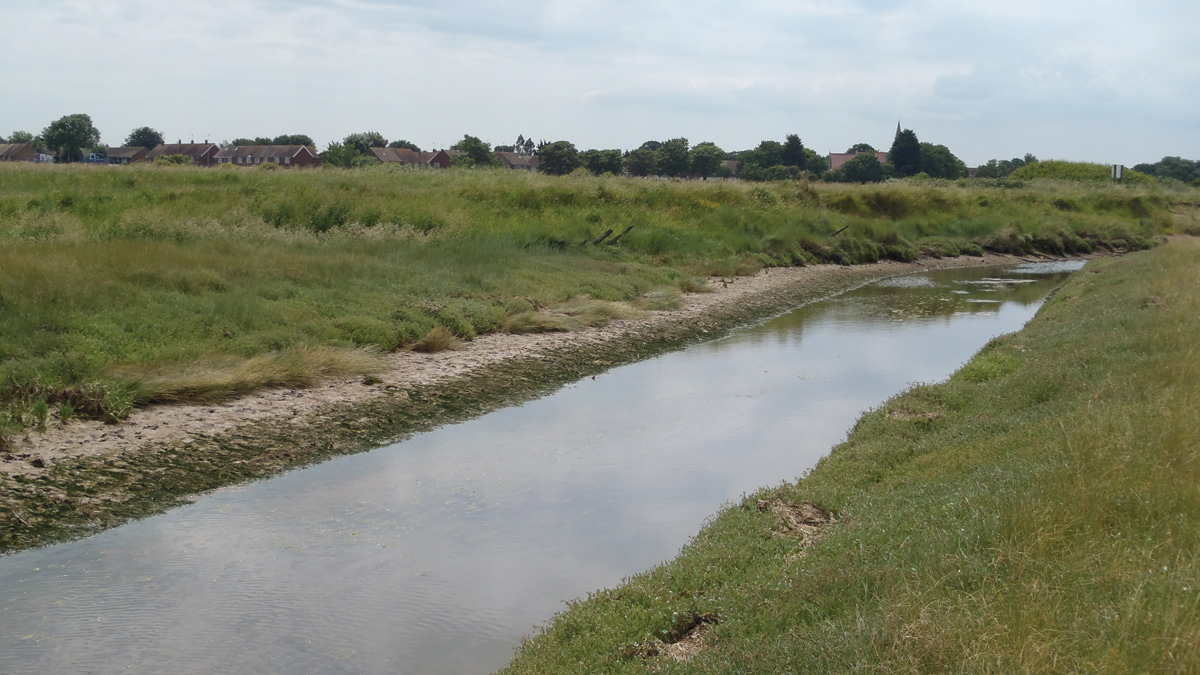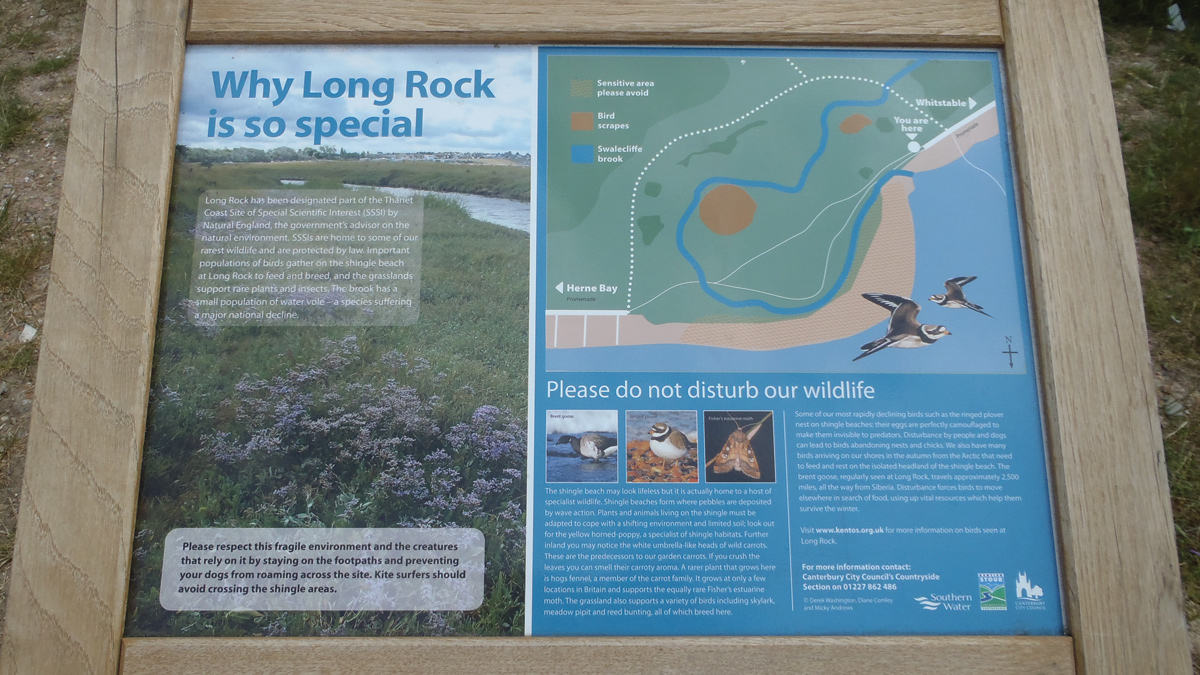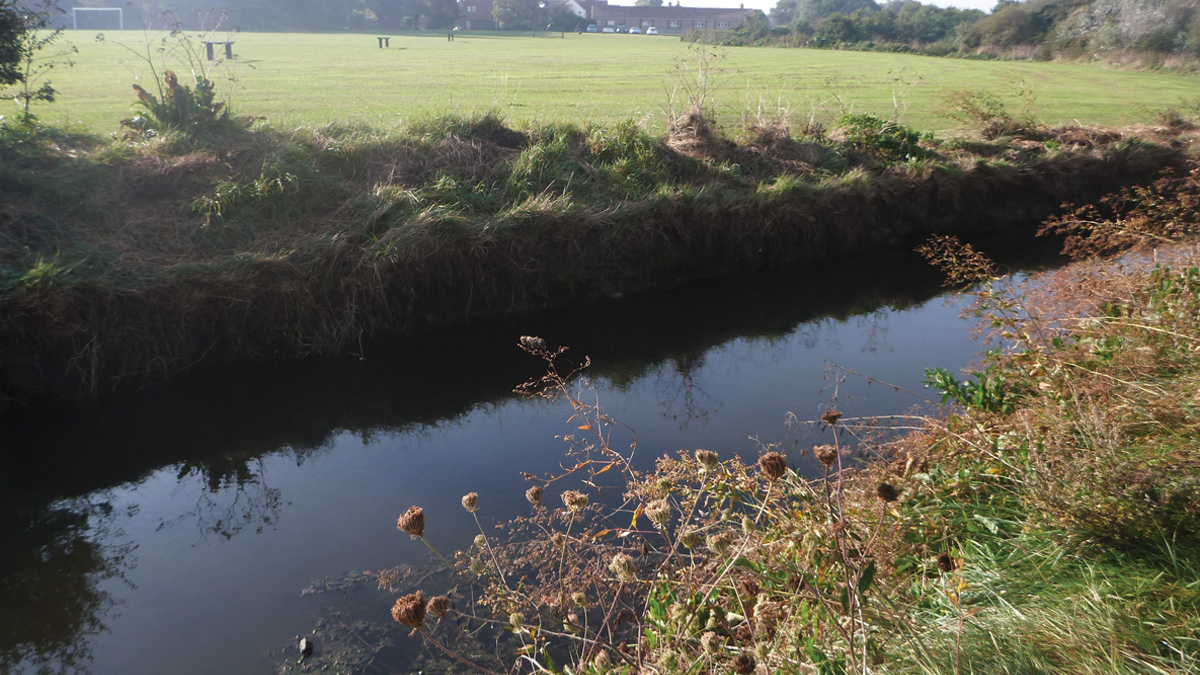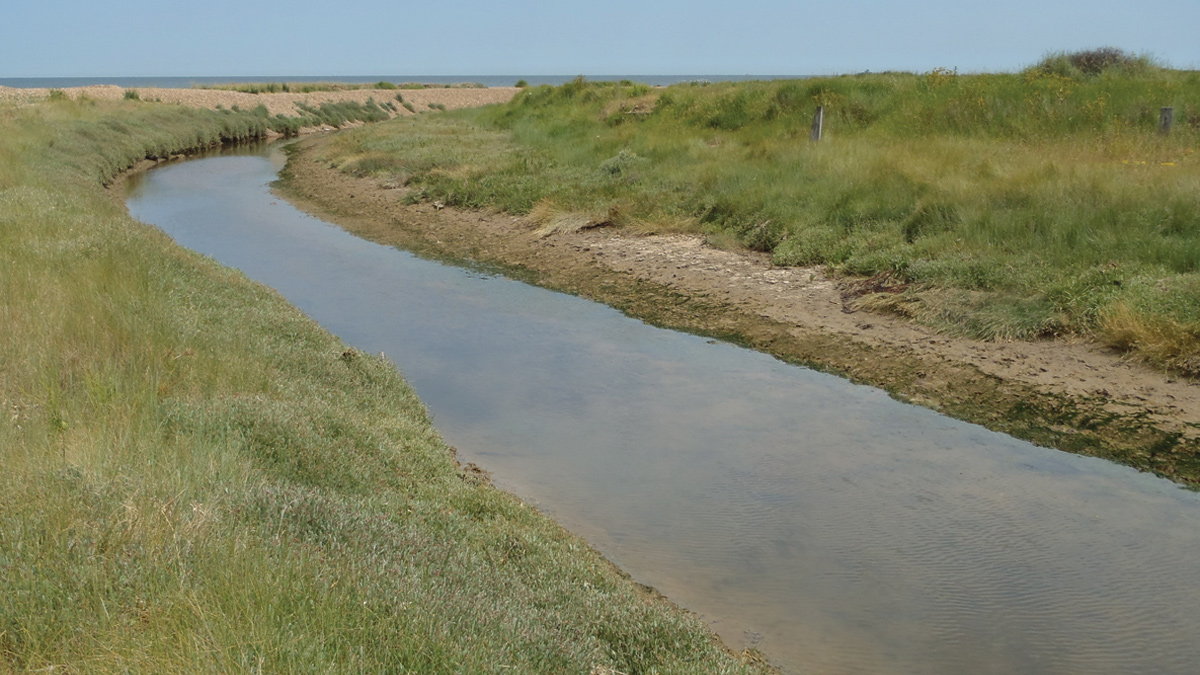Swalecliffe Habitat Resilience Plan (2016)

The brook habitat both in channel and surrounding terrestrial habitat at Swalecliffe - Courtesy of Mott MacDonald
Resilience is a key metric when developing, improving and managing habitat systems and their associated ecology across diverse coastal and urban environments where wastewater treatment plants reside. The study site for this paper is located within the Thanet Coast Biodiversity Opportunity Area (BOA) and Site of Special Scientific Interest (SSSI) Impact Risk Zone for the Thanet Coast SSSI. Adjacent to the wastewater treatment works (WwTW) is Thanet Coast & Sandwich Bay Ramsar wetland of international importance, Thanet Coast & Sandwich Bay Special Protection Area (SPA) and Thanet Coast Special Area of Conservation (SAC).
Background
Following an incident on 21 July 2013 at Southern Water’s Swalecliffe WwTW, wastewater was discharged through the emergency overflow into Swalecliffe Brook. It became clear during the mitigation works, which incorporated gap analysis and cumulative impacts studies, that adding value to the local watercourse could help to support the ecology of the brook while supporting the local ecology. In other words, the quality of the receiving watercourse prior to the incident had been degraded by diffuse and other sources of pollution, reducing the brooks capacity to deal with the spill.
With this in mind a habitat resilience plan (HRP) was put in place with the principal aim to add value and enhance in situ habitats to make them more resilient to any future spills (subject to permitting conditions) through ecological planning.
The overarching aim in the longer term would be to counter the attritional ecological consequence of repeated permitted spills and other sources of diffuse pollution by increasing the resilience of the aquatic and riparian habitats present in the immediate area of the CSO discharge point, while reducing the risk of future spills in line with the permitted terms and conditions.
This study has identified a number of options to increase the ecological value of the brook habitat both in channel and surrounding terrestrial habitat with the primary focus being on building in ecological resilience. Part of the resilience planning involves the use of a new term called resilience DNA (Res DNA).
Res DNA in this context is defined as the fundamental and distinctive characteristics or qualities of a habitat in regard to its genetic and physical make up, while understanding this intrinsic coding and how you work with it to boost resilience into your chosen habitats and environment. For this project it was used as a pioneering approach to try to increase ecological resilience and capacity in Swalecliffe brook while focusing on supporting water quality, amenity value, animal health and flora in situ.

As part of the Thanet Special Site of Scientific Interest (SSSI) Long Rock forms irregular gravel spread on the foreshore to the east of Tankerton and north of Swalecliffe – Courtesy of Mott MacDonald
The ecological resilience challenge/assessment
The concept of resilience in ecological systems was first introduced by CS Holling [3] in order to describe the persistence of natural systems in the face of changes in ecosystem variables due to natural or anthropogenic causes or impacts. Resilience has been defined in two ways in ecological literature:
- The time required for an ecosystem to return to an equilibrium or steady-state following a perturbation (which is also defined as stability by some authors Holling [3]). This definition of resilience is used in other fields such as physics and engineering, and hence has been termed ‘engineering resilience’ by Holling [3] and Gunderson [4].
- The capacity of a system to absorb disturbance and reorganize while undergoing change so as to still retain essentially the same function, structure, identity, and feedbacks [4].
The second definition has been termed ‘ecological resilience’, and it presumes the existence of multiple stable states or regimes [3]. The quality of resilience in habitats and ecosystems commonly applies to surrounding habitats (beside WwTWs and the coastal environment) and its ability to withstand and recover from accidental and permitted spills, overflows and ever changing weather patterns, along with increasing anthropogenic influences.
These often destructive external forces reduce a habitat’s ability to recover naturally and further reduce its ability to process these impacts and recover from them. Habitat impacts can be attributed to human, wildlife and natural ecosystems and it is up to us and how well we manage and protect the natural environment from these impacts. We need to build and invest in partnerships achieving effective and sustainable outcomes that champion the resilience theme and build in ecological resilience not just incorporating the use of technology on WwTW sites and infrastructural developments. Ecology and these other areas now provide an opportunity for a more joined up thinking and holistic approach.
The interactions between WwTWs and ecological systems exist in every community at every scale – local, national, and global. In recent years, processes for implementing and improving systems have come to focus, not only on sustainability measures, but also on a habitat’s adaptive capacity to address future and current, as well as cumulative, environmental changes. We need to build and invest in partnerships achieving effective and sustainable outcomes and invest in ResDNA.
Loosely speaking by tapping into this well-defined genetical ecology of the habitats in question with the focus being to use this ecological structure to bind, and support the delivery of ecosystem services. The key aim is to try to future-proof the current environment and build in adaptive capacity that a strong ecological habitat can provide and be able to survive from ever increasing external future pressures. The adaptive capacity in some habitat’s requires extra support, areas where value can be added and these riparian habitats to be restored to more favourable status, thus increasing its carrying capacity and ability to deal with ever increasing cumulative impacts and giving this habitat an element of future-proofing resilience.
When habitats face such strong socio-economic and ecologic dynamic conditions, how do we enhance each habitat’s unique capacity for adaptation and resilience in order to sustain its critical ecosystem services, biodiversity and wildlife?
The solutions to increasing resilience in coastal habitats where WwTWs reside and discharge is not ‘one size fits all’. By sharing knowledge and working together, we can achieve cost-effective and resilient habitat systems to meet a changing world through locally-developed applications.

The brook habitat both in channel and surrounding terrestrial habitat at Swalecliffe – Courtesy of Mott MacDonald
Proposed implementation phase
According to the River Basin Management Plan, Swalecliffe Brook is a heavily modified water body described as a small calcareous brook that experiences slow flow, high turbidity and lack of in-stream and riparian vegetation [1]. Its ecological status is currently assessed by the River Basin Management Plan as Moderate Potential (meaning being within reasonable limits; not excessive or extreme: based on professional judgement) [1].
Based on observations made during the previous CSO spill incidents, fish species were present in low numbers and affected by the discharges were eels (Anguilla anguilla), sticklebacks (possibly three spined stickleback Gasterosteus aculeatus) and possibly trout (Salmo trutta). In addition, water voles (Arvicola amphibius) are also known to inhabit the brook. For the purpose of this study, eels and water voles were therefore identified as key species which would benefit the most from an enhancement scheme for the brook.
As mentioned, the study site is located within the Thanet Coast Biodiversity Opportunity Area (BOA) and Site of Special Scientific Interest (SSSI) Impact Risk Zone for the Thanet Coast SSSI. Adjacent to the WwTW is Thanet Coast & Sandwich Bay Ramsar wetland of international importance, Thanet Coast & Sandwich Bay Special Protection Area (SPA) and Thanet Coast Special Area of Conservation (SAC).
The habitats within the Southern Water landholding between Swalecliffe Brook and the WwTW boundary fence are of local ornithological (particularly migratory songbirds) and entomological (insect) interest. Common lizard (Zootoca vivipara), protected under the Wildlife and Countryside Act 1981 (as amended) was observed on site. Water vole (Arvicola amphibius) and slow-worm (Anguis fragilis) (protected species) have also been observed within the wider area.
Taking this into consideration this plan suggested a number of options which should be investigated further and where possible implemented to support habitats present near the WwTW. The first step of this Habitat Resilience Plan consists of specific ecology surveys to clearly establish the baseline. These surveys included:
- Water quality monitoring.
- River corridor survey.
- Preliminary Ecological Appraisal (PEA).
- Protected species surveys recommended in the PEA which may include fish, water vole, reptiles and invertebrates.
- Intertidal survey near seaward terminus of brook.
The first surveys carried out under the proposed monitoring programme defined the baseline status and conditions. The information collected enabled options to be designed in more detail improving their efficiency and outcomes. Associated studies included a study of the brook bed to understand the sediment composition and depth. A number of options were explored to support ecological resilience of the brook habitat both in channel and surrounding terrestrial habitat. These include:
- Cleaning of river bed: Reducing the amount of silt and consequently nutrients of the river bed. Reducing the levels of sediments will also benefit water clarity and promote the growth of riparian vegetation. However removal of silt may result in lowering the brook bed in some locations which would be undesirable due to the very low gradient of the Brook. This could potentially reduce flow and create areas of stagnant water. An initial study of the brook would need to be carried out prior to cleaning to identify the brook substrate composition and an estimation of the silt layer depth. This will allow an understanding of the potential effects and benefits of cleaning the brook.
- Riparian works: Adding a strip of riparian vegetation on the left bank of the brook within the Southern Water landholding with the purpose of improving habitat variability and suitability for both water voles and eels.
- Reptile habitat enhancement: Enclosure, grassland management, provision of refuge and basking sites.
- Bird habitat enhancement: Enclosure, scrub management, provision of freshwater features and nest boxes.

The view from the brook looking seawards and habitats both in channel and surrounding terrestrial habitat – Courtesy of Mott MacDonald
Conclusion
In order to build in more resilience into essential life-giving habitats that surround the WwTW the steps outlined above should be taken. The aim is to deliver and support essential resilient habitats through integrated ecological resilience strategies coupled with investment in ecology and habitats. Resilience should aim to focus on habitats that support water quality, amenity value, animal health and flora, building in ecological resilience into each of these stages through the use of ResDNA.
References
- [1] Environment Agency (2009) River Basin Management Plan, South East River Basin District Report.
- [2] Peterson, G., Allen, C.R., Holling, C.S. (1998). ‘Ecological Resilience, Biodiversity, and Scale’. Ecosystems 1 (1): 6–18.
- [3] Holling, C.S. (1973). ‘Resilience and stability of ecological systems’. Annual Review of Ecology and Systematics 4: 1–23.
- [4] Gunderson, L.H. (2000). ‘Ecological Resilience – In Theory and Application’. Annual Review of Ecology and Systematics 31: 425–439.




